AI Camera Market Size
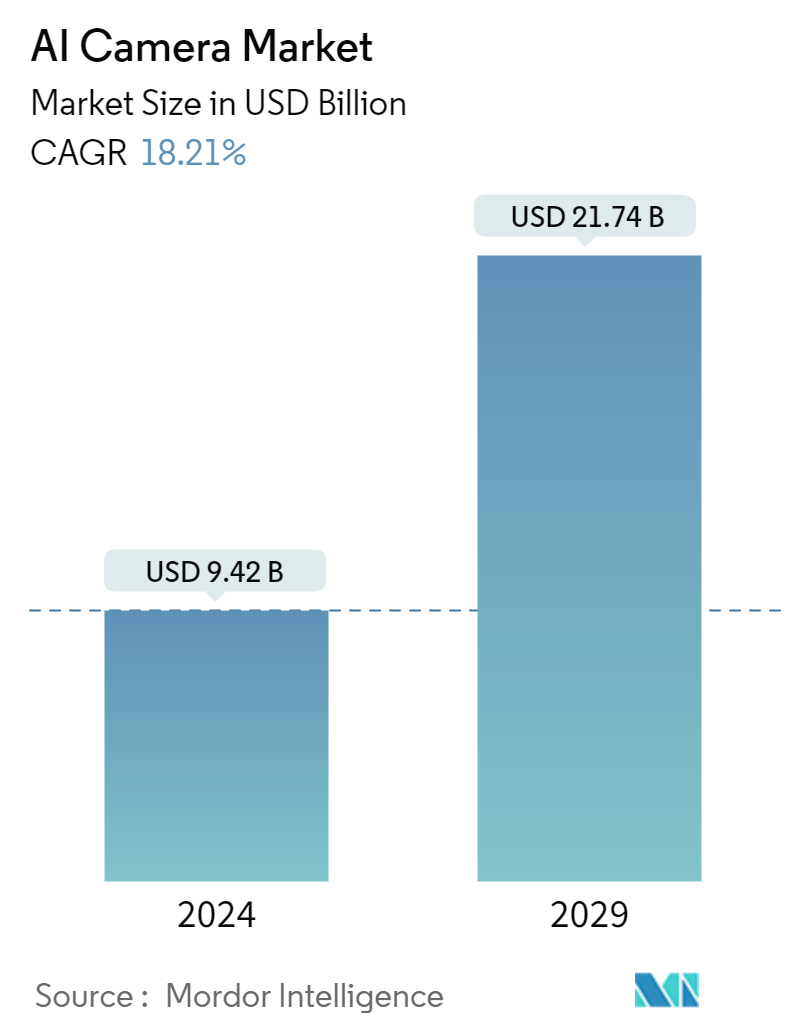
| Study Period | 2019 - 2029 |
| Market Size (2024) | USD 9.42 Billion |
| Market Size (2029) | USD 21.74 Billion |
| CAGR (2024 - 2029) | 18.21 % |
| Fastest Growing Market | North America |
| Largest Market | Asia Pacific |
Major Players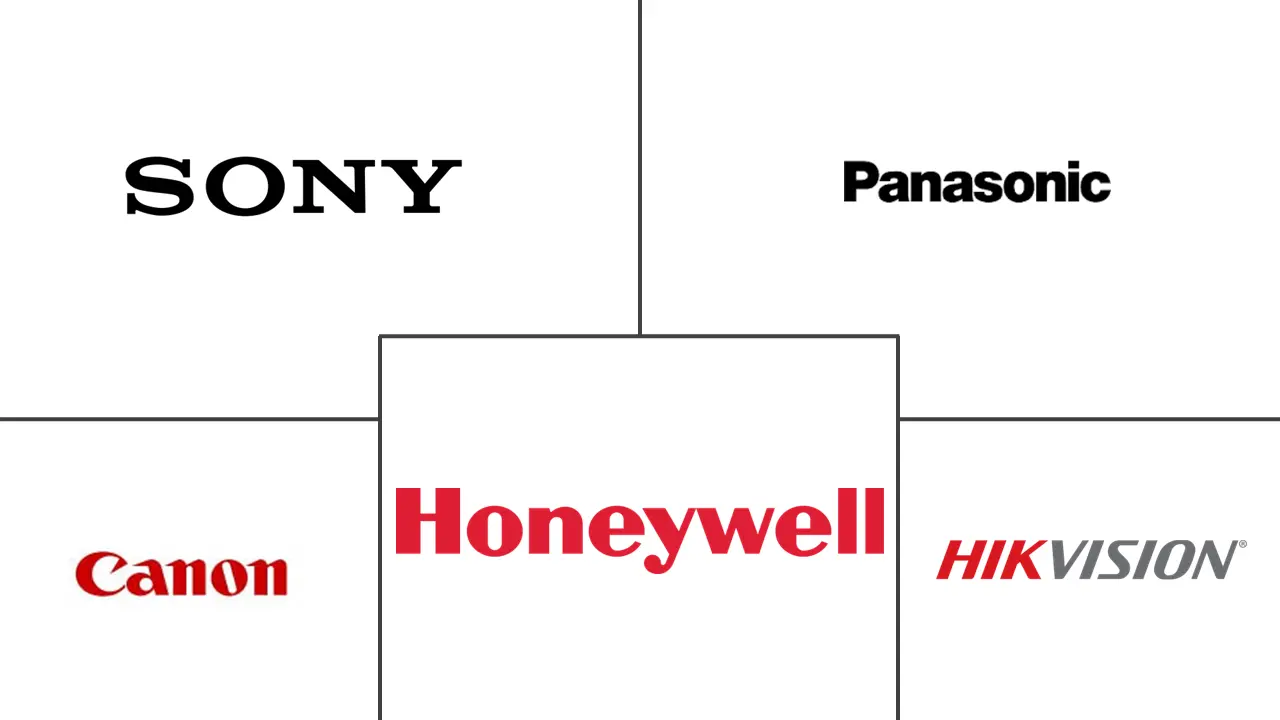
*Disclaimer: Major Players sorted in no particular order |
AI Camera Market Analysis
The AI Camera Market size is estimated at USD 9.42 billion in 2024, and is expected to reach USD 21.74 billion by 2029, growing at a CAGR of 18.21% during the forecast period (2024-2029).
- AI cameras are witnessing a growing demand due to the increasing need for safety and versatile applications. These devices are pivotal in enhancing public safety, with applications spanning traffic management, accident detection, and disaster response. AI cameras effectively shorten response times to security incidents by providing real-time analysis and alerts. In addition, AI security cameras are increasingly pivotal in enhancing security, curbing crime, and offering crucial data for informed decision-making, fueling the market's growth.
- In May 2024, Maharashtra, India, announced its plans to deploy a series of artificial intelligence (AI) cameras across all highways. This initiative aims to reduce accidents and fatalities throughout the state. Maharashtra approved the installation of AI cameras on nine of its highways. These advanced cameras are designed to detect a range of common road offences. Such offences encompass speeding, lane cutting, driving on the wrong side, and even using mobile phones while driving. Equipped with sophisticated sensors and software, the AI-powered cameras can analyze live footage, recognize number plates, and identify traffic anomalies in real-time.
- AI cameras are transforming patient monitoring in the healthcare sector, while in retail, they play a crucial role in analyzing customer behaviour. AI cameras enhance quality control in manufacturing, underscoring the technology's versatility and adaptability. In December 2023, HonorHealth sought AI solutions to analyze camera footage.
- The company aims to leverage AI to receive alerts, reducing the need to review each camera feed or retrace the steps manually. AI can detect anomalies, like a visitor donning a heavy coat in Arizona's sweltering 100-degree heat. Moreover, while facial recognition proves beneficial, the capability to identify objects, such as an unoccupied wheelchair in a hallway or a neglected wet floor, plays a crucial role in accident prevention.
- AI cameras help monitor public spaces, identify potential threats, and assist law enforcement in criminal investigations, leading to increased adoption by municipalities and government agencies. In July 2024, Britain launched a new generation of AI-driven speed cameras to enhance road safety. These advanced cameras will monitor and catch drivers for speeding, mobile phone usage, and seatbelt violations. Greenlit by the Department for Transport, this initiative aims to strengthen driving law enforcement and mitigate hazardous driving behaviours nationwide.
- AI cameras generate and store large amounts of data, making them targets for cyberattacks. Concerns over data breaches and the security of sensitive information can deter organizations from adopting AI cameras. In addition, increasing regulations related to data privacy (such as GDPR in Europe) and surveillance could restrict the deployment and usage of AI cameras. Compliance with these regulations can be costly and complex. Moreover, AI cameras generally require more power compared to traditional cameras due to the processing capabilities they support. This can be a militing factor in remote or off-grid locations.
- Macroeconomic factors like regulations governing the use of surveillance technology can limit the deployment of AI cameras. These laws may restrict where and how AI cameras can be used, affecting market expansion, especially in public and sensitive areas. Moreover, positive international relations facilitate cross-border investments, technology transfers, and joint ventures, driving innovation and growth in the AI camera market. Conversely, strained relations can lead to trade restrictions, limiting market expansion.
AI Camera Market Trends
Law Enforcement and Public Sector is Expected to Witness a Significant Growth
- Governments are increasingly deploying AI cameras for surveillance in public spaces to prevent crime and enhance law enforcement capabilities. AI cameras are equipped with facial recognition, behaviour analysis, and object detection and are used to monitor public areas, identify potential threats, and assist in criminal investigations.
- In January 2024, the Delhi government announced its plans to deploy AI cameras across the national capital, aiming to bolster road safety and monitor traffic rule violations. These AI-driven cameras are designed to identify 19 specific traffic infractions, including mobile phone usage while driving, operating without a valid Pollution Under Control Certificate (PUCC), and triple riding on motorcycles.
- AI cameras are widely used to monitor traffic and automatically detect violations such as speeding, running red lights, and illegal parking. This automation reduces the need for manual enforcement and enhances road safety. In May 2024, the Mysuru City police launched the Intelligent Traffic Management System, leveraging AI-powered cameras to monitor violations and issue real-time tickets to vehicle owners. These 24/7 cameras will monitor and record traffic violations such as speeding, using mobile phones while driving, and neglecting to wear seat belts or helmets.
- AI cameras are integrated with predictive policing systems that analyze data to anticipate where crimes are likely to occur. This allows law enforcement to deploy resources more effectively and prevent crimes before they happen. AI cameras are used with drones or robotic systems to conduct automated patrols in difficult or dangerous areas for human officers to monitor. These systems can detect and report suspicious activities in real time.
- The demand for AI cameras is increasing rapidly as these cameras are used for cross-border areas and controlling entry points such as airports and seaports. These help detect illegal crossings, smuggling activities, and unauthorized access, ensuring national security. In June 2024, Mumbai International Airport Limited announced its plans to boost its passenger processing capacity by deploying AI-enabled cameras. This strategic enhancement underscores the airport's commitment to fostering a more efficient, secure, and passenger-centric environment.
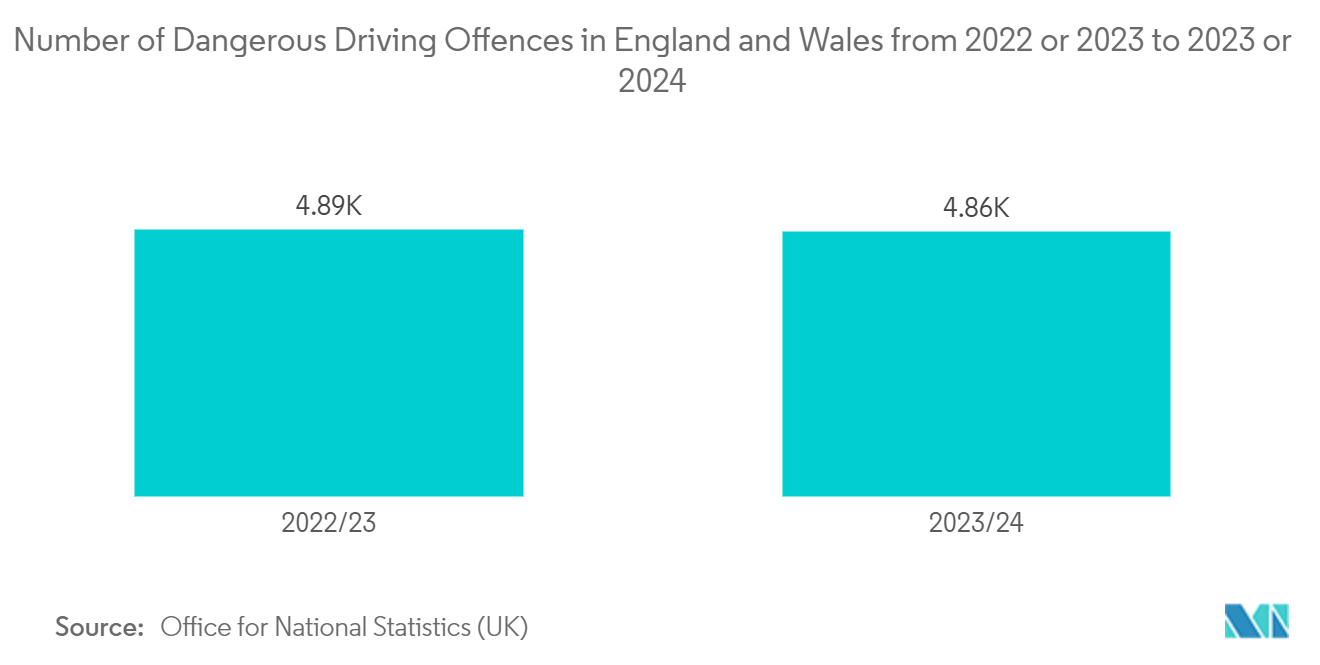
Asia Pacific is Expected to Hold a Significant Market Share
- Many countries in the Asia-Pacific region, such as China, India, Singapore, and South Korea, are heavily investing in smart city initiatives. AI cameras play a significant role in these projects by providing real-time monitoring, traffic management, crime prevention, and infrastructure management. Governments across the region are deploying AI cameras to enhance the quality of urban life and improve the efficiency of city services. In July 2024, Bengaluru's traffic police announced its plans to enhance AI cameras, expanding their detection capability from seven to nearly ten traffic violations.
- Asia Pacific is home to leading technology hubs, including China, Japan, South Korea, and Taiwan. Local manufacturers in these countries are at the forefront of developing advanced AI cameras. In February 2024, IDIS, the leading domestic video technology manufacturer in South Korea, broadened its lineup of edge AI cameras. This expansion aims to enable a more comprehensive array of customers to leverage top-tier deep-learning video analytics. These analytics can be applied across commercial properties, public areas, and perimeters, effectively minimizing false alarms and directing advanced AI-driven analytics to their most critical locations.
- The APAC region is one of the largest markets for consumer electronics, including smartphones, home security systems, and IoT devices, many of which are equipped with AI cameras. The high penetration of these devices in the region fuels the demand for AI cameras, both as standalone products and as integrated components.
- The booming retail sector in the Asia-Pacific region is increasingly adopting AI cameras for various applications, including customer behaviour analysis and security. AI cameras help retailers optimize operations and enhance the customer experience, driving demand in this sector. In April 2024, Sony deployed AI cameras across 500 7-Eleven stores in Japan for enhanced consumer analysis. The devices leverage on-sensor AI processing to identify when customers engage with digital signage automatically, tally the number of individuals who paused to view it, and assess the viewer engagement percentage.
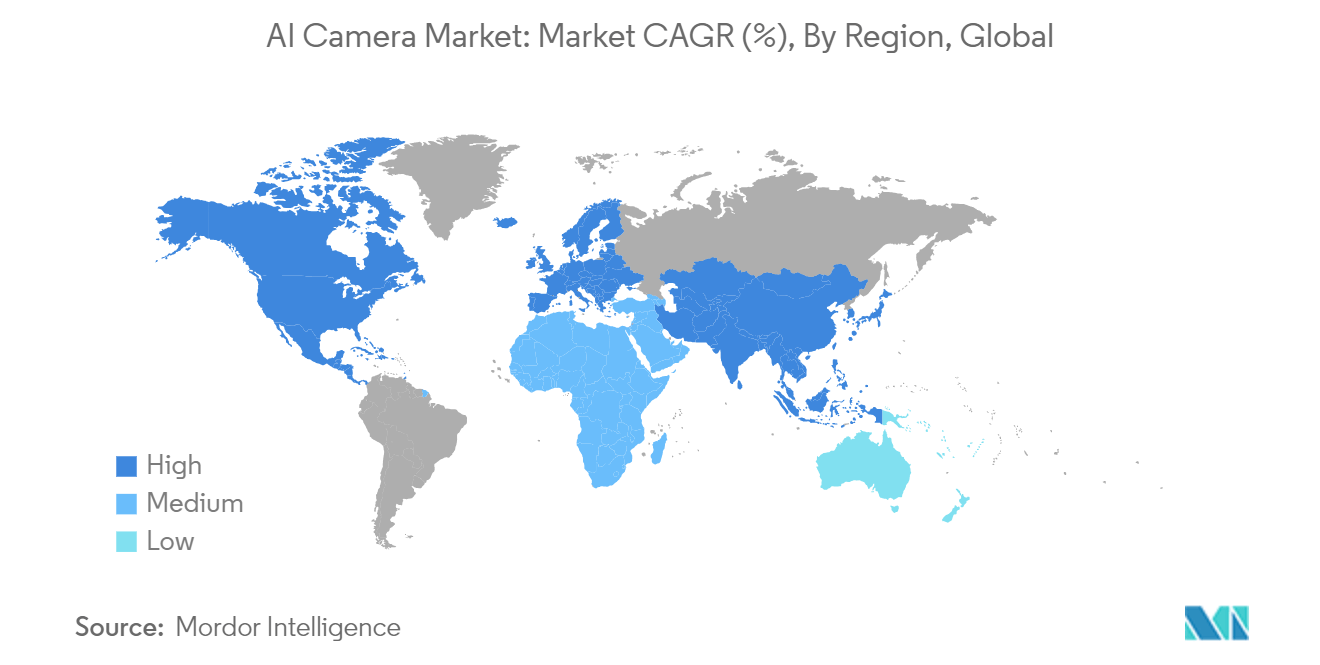
AI Camera Industry Overview
The AI Camera Market is fragmented, with the presence of significant players like Sony Corporation, Panasonic Corporation, Canon Inc., Honeywell International Inc., Hangzhou Hikvision Digital Technology Co., Ltd, Dahua Technology Co Ltd., Eagle Eye Networks Ltd, Hanwha Vision Inc., D-Link Limited, Vivotek, Inc., and many others. Significant players in the market are adopting strategies such as partnerships, mergers, expansions, innovations, investments, and acquisitions to enhance product offerings and gain sustainable competitive advantage.
- In July 2024, Realme partnered with Sony to enhance mobile photography through AI and advanced camera technology in Realme's forthcoming 5G smartphones. This partnership marks the debut of Sony's LYT-701 camera sensor in Realme's 13 Pro Series 5G. These devices will feature the LYT-701 camera sensor and a 50MP periscope telephoto camera equipped with Sony's LYT-600, guaranteeing superior image quality. Furthermore, the phones will come with on-device AI imaging algorithms and cloud-based AI image editing features.
- In January 2024, Indie Semiconductor, Inc., an innovator in Autotech solutions, partnered with Ficosa, a firm specializing in advanced vision, safety, and efficiency solutions for the automotive sector. The companies have inked a collaboration agreement focused on developing and commercializing automotive camera solutions that utilize neural network-based (NN) artificial intelligence (AI) processing. The company plans to unveil the inaugural smart camera solutions, leveraging the joint technologies, in 2024, with an ambitious goal of entering volume production by 2025.
AI Camera Market Leaders
-
Sony Corporation
-
Panasonic Corporation
-
Canon Inc.
-
Honeywell International Inc.
-
Hangzhou Hikvision Digital Technology Co., Ltd
*Disclaimer: Major Players sorted in no particular order
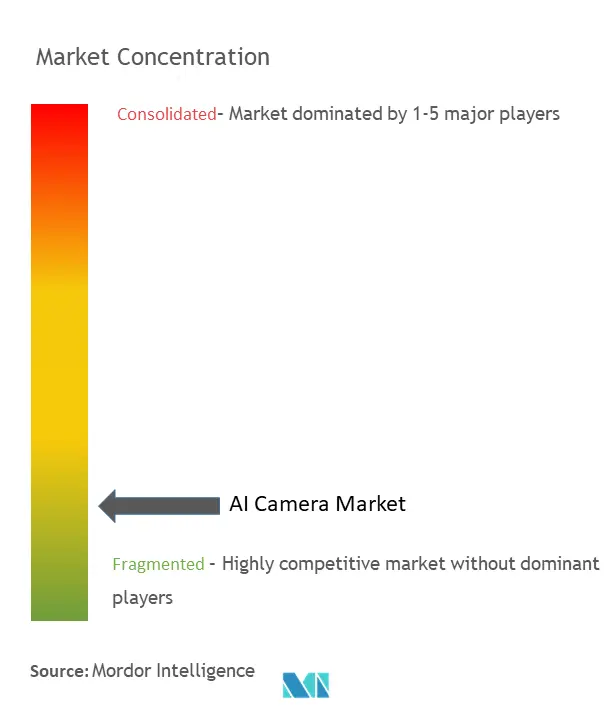
AI Camera Market News
- May 2024: Teledyne Technologies subsidiary Flir has introduced the Trafibot AI 4K visible camera system, designed specifically for interurban traffic intelligence. This advanced closed-circuit camera harnesses the latest artificial intelligence (AI) to ensure top-tier detection performance. It guarantees dependable traffic data collection across interurban roadways, from highways to tunnels. Notably, it achieves this without compromising imaging resolution or facing data loss from bandwidth constraints.
- April 2024: Sony Electronics is releasing the BRC-AM7, a flagship 4K 60p pan-tilt-zoom (PTZ) camera model with an integrated lens. Incorporating PTZ Auto Framing technology, which uses artificial intelligence (AI) technology for advanced recognition, the camera facilitates accurate and natural automatic tracking of moving subjects. These innovations enable simplified, high-quality video production for broadcast, live events, and sports productions. The company recently integrated AI-driven auto-tracking and auto-framing technology into its models, receiving positive feedback.
AI Camera Market Report - Table of Contents
1. INTRODUCTION
- 1.1 Study Assumptions and Market Definition
- 1.2 Scope of the Study
2. RESEARCH METHODOLOGY
3. EXECUTIVE SUMMARY
4. MARKET INSIGHTS
- 4.1 Market Overview
-
4.2 Industry Attractiveness - Porter's Five Forces Analysis
- 4.2.1 Bargaining Power of Suppliers
- 4.2.2 Bargaining Power of Consumers
- 4.2.3 Threat of New Entrants
- 4.2.4 Threat of Substitute Products
- 4.2.5 Intensity of Competitive Rivalry
- 4.3 Industry Value Chain Analysis
- 4.4 Impact of COVID-19 Aftereffects and Other Macroeconomic Factors on the Market
5. MARKET DYNAMICS
-
5.1 Market Drivers
- 5.1.1 Rising Demand in Security and Surveillance
- 5.1.2 Global Push Towards Smart Cities
-
5.2 Market Restraint
- 5.2.1 Privacy and Security Concerns
6. MARKET SEGMENTATION
-
6.1 By Type
- 6.1.1 Surveillance Cameras
- 6.1.2 DSLR Cameras
- 6.1.3 Smartphone Cameras
- 6.1.4 Others
-
6.2 By Offering
- 6.2.1 Image Sensors
- 6.2.2 Memory and Storage
- 6.2.3 Processors
- 6.2.4 Others
-
6.3 By Technology
- 6.3.1 Object Detection and Recognition
- 6.3.2 Facial Recognition
- 6.3.3 Night Vision
- 6.3.4 Motion Detection
- 6.3.5 Others
-
6.4 By End-user Industry
- 6.4.1 Law Enforcement and Public Sector
- 6.4.2 Healthcare
- 6.4.3 Retail
- 6.4.4 Automotive
- 6.4.5 Industrial
- 6.4.6 BFSI
- 6.4.7 Others
-
6.5 By Geography***
- 6.5.1 North America
- 6.5.2 Europe
- 6.5.3 Asia
- 6.5.4 Latin America
- 6.5.5 Middle East and Africa
7. COMPETITIVE LANDSCAPE
-
7.1 Company Profiles
- 7.1.1 Sony Corporation
- 7.1.2 Panasonic Corporation
- 7.1.3 Canon Inc.
- 7.1.4 Honeywell International Inc.
- 7.1.5 Hangzhou Hikvision Digital Technology Co., Ltd
- 7.1.6 Dahua Technology Co Ltd.
- 7.1.7 Eagle Eye Networks Ltd
- 7.1.8 Hanwha Vision Inc.
- 7.1.9 D-Link Limited
- 7.1.10 Vivotek, Inc.
- *List Not Exhaustive
8. INVESTMENT ANALYSIS
9. FUTURE OF THE MARKET
** Subject To AvailablityAI Camera Industry Segmentation
AI camera is a security device with advanced technology, enabling it to interpret its surroundings. Leveraging technologies like machine learning (ML), these cameras analyse visuals, cross-referencing them with databases and other data sources to enhance users' insights. AI cameras enhance business security and promote informed decision-making. By introducing services like video alarms, AI cameras enable owners to detect events promptly, validate alarms, and transmit real-time footage to emergency responders.
The study tracks the revenue accrued through the sale of AI camera types by various players globally. The study also tracks the key market parameters, underlying growth influencers, and major vendors operating in the industry, which supports the market estimations and growth rates over the forecast period. The study further analyses the overall impact of COVID-19 aftereffects and other macroeconomic factors on the market. The report's scope encompasses market sizing and forecasts for the various market segments.
The AI Camera Market is Segmented by type (surveillance cameras, DSLR cameras, smartphone cameras, and others), offering (image sensors, memory and storage, processors, and others), technology (object detection and recognition, facial recognition, night vision, motion detection, and others), end-user industry (law enforcement and public sector, healthcare, retail, automotive, industrial, BFSI, and others), and geography (North America, Europe, Asia-Pacific, Latin America, and Middle East and Africa). The market sizes and forecasts are provided in terms of value (USD) for all the above segments.
| By Type | Surveillance Cameras |
| DSLR Cameras | |
| Smartphone Cameras | |
| Others | |
| By Offering | Image Sensors |
| Memory and Storage | |
| Processors | |
| Others | |
| By Technology | Object Detection and Recognition |
| Facial Recognition | |
| Night Vision | |
| Motion Detection | |
| Others | |
| By End-user Industry | Law Enforcement and Public Sector |
| Healthcare | |
| Retail | |
| Automotive | |
| Industrial | |
| BFSI | |
| Others | |
| By Geography*** | North America |
| Europe | |
| Asia | |
| Latin America | |
| Middle East and Africa |
AI Camera Market Research FAQs
How big is the AI Camera Market?
The AI Camera Market size is expected to reach USD 9.42 billion in 2024 and grow at a CAGR of 18.21% to reach USD 21.74 billion by 2029.
What is the current AI Camera Market size?
In 2024, the AI Camera Market size is expected to reach USD 9.42 billion.
Who are the key players in AI Camera Market?
Sony Corporation, Panasonic Corporation, Canon Inc., Honeywell International Inc. and Hangzhou Hikvision Digital Technology Co., Ltd are the major companies operating in the AI Camera Market.
Which is the fastest growing region in AI Camera Market?
North America is estimated to grow at the highest CAGR over the forecast period (2024-2029).
Which region has the biggest share in AI Camera Market?
In 2024, the Asia Pacific accounts for the largest market share in AI Camera Market.
What years does this AI Camera Market cover, and what was the market size in 2023?
In 2023, the AI Camera Market size was estimated at USD 7.70 billion. The report covers the AI Camera Market historical market size for years: 2019, 2020, 2021, 2022 and 2023. The report also forecasts the AI Camera Market size for years: 2024, 2025, 2026, 2027, 2028 and 2029.
AI Camera Industry Report
Statistics for the 2024 AI Camera market share, size and revenue growth rate, created by Mordor Intelligence™ Industry Reports. AI Camera analysis includes a market forecast outlook for 2024 to 2029 and historical overview. Get a sample of this industry analysis as a free report PDF download.



